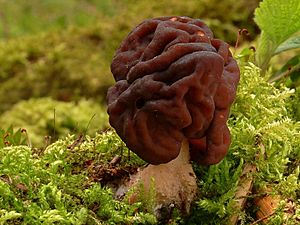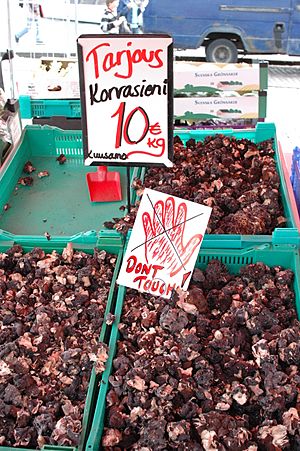Gyromitra esculenta facts for kids
The Gyromitra esculenta is a type of fungus often called the "brain mushroom" or "false morel." It grows in Europe and North America, usually in sandy soil under pine trees during spring and early summer. Its cap looks like a brain, is dark brown, and can be up to 10 cm (4 inches) tall and 15 cm (6 inches) wide. It sits on a thick white stem.
Quick facts for kids Gyromitra esculenta |
|
|---|---|
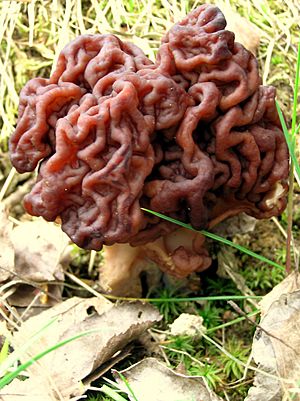 |
|
| Scientific classification | |
| Genus: |
Gyromitra
|
| Species: |
esculenta
|
| Synonyms | |
|
|
| Gyromitra esculenta | |
|---|---|
| Mycological characteristics | |
| smooth hymenium | |
| cap is convex | |
| hymenium attachment is not applicable | |
| stipe is bare | |
| spore print is yellow to buff | |
| ecology is saprotrophic or mycorrhizal | |
| edibility: deadly or choice | |
Even though it can be deadly if eaten raw, this mushroom is a popular food in some parts of Scandinavia, Eastern Europe, and the Great Lakes region of North America. However, in places like Spain, it's not allowed to be sold. In Finland, it can be sold fresh, but it must come with clear warnings and instructions on how to prepare it safely.
When you eat Gyromitra esculenta, a harmful substance called gyromitrin turns into a strong toxin called monomethylhydrazine (MMH), which is also used in rocket fuel! This toxin can hurt your liver, brain, and sometimes your kidneys. Symptoms of poisoning include throwing up and diarrhea a few hours after eating. Later, you might feel dizzy, tired, and have a headache. In serious cases, it can lead to confusion, coma, and even death after five to seven days.
Contents
Taxonomy and Naming
How it Got its Name
The Gyromitra esculenta was first described in 1800 by a scientist named Christiaan Hendrik Persoon. He called it Helvella esculenta. Later, in 1849, another scientist, Elias Magnus Fries, moved it to the genus Gyromitra, which is its official name today.
The name Gyromitra comes from ancient Greek words: gyros meaning "round" and mitra meaning "headband." The second part of its name, esculenta, comes from the Latin word for "edible."
People have given it many common names like "brain mushroom," "turban fungus," "elephant ears," or "beefsteak mushroom." However, "beefsteak mushroom" can also refer to a different, much less toxic mushroom.
False Morels
Gyromitra esculenta is part of a group of fungi known as "false morels." They are called this because they look a bit like the highly prized "true morels" (from the genus Morchella). Other false morels include Gyromitra infula and Gyromitra gigas.
Even though some of these false morels might not have much gyromitrin, many mushroom guidebooks suggest treating all of them as poisonous. This is because they look very similar, and it can be hard to tell them apart safely. The toxic effects of G. esculenta can be reduced by cooking, but it might not be enough to prevent poisoning if you eat them often.
Description
The cap of Gyromitra esculenta looks like a brain and has an irregular shape. It can be up to 10 cm (4 inches) tall and 15 cm (6 inches) wide. When it's young, it's smooth, but it gets more wrinkled as it grows older. The cap can be reddish-brown, chestnut, purplish, or dark brown. It turns black as it ages.
The stem is 3 to 6 cm (1 to 2.5 inches) tall and 1 to 5 cm (0.4 to 2 inches) wide. Some say it's solid, while others say it's hollow, like true morels. The mushroom can have a pleasant, fruity smell and a mild taste. Its spores are whitish and oval-shaped.
Similar Mushrooms
Gyromitra esculenta looks similar to true morels, but true morels are more symmetrical and look like pitted gray, tan, or brown sponges. The cap of Gyromitra esculenta is usually darker and larger. Other similar species include Gyromitra gigas, G. infula, and Gyromitra ambigua. The last two are also toxic to humans.
Distribution and Habitat
Gyromitra esculenta grows in sandy soil in coniferous (pine) forests and sometimes in deciduous (leafy) forests. You can mostly find it under pine trees, but sometimes under aspen trees too. The best time to find it is from April to July, often appearing when the snow melts. Some years it's very common, and other years it's rare.
This mushroom is often found in places where the ground has been disturbed, like clearings, riverbeds, or roadsides. In Finland, some people even bury newspaper with the fungus in the ground in autumn to collect mushrooms the next spring!
You can find Gyromitra esculenta across North America, from the Sierra Nevada mountains to Mexico. It's also common in Central Europe, and less so in Eastern Europe. It has been found in Northern Ireland and parts of Turkey.
Toxicity
People have known about the toxic effects of Gyromitra esculenta for at least a hundred years. For a long time, experts thought the reactions might be allergies or misidentifications because some people got very sick while others didn't, even after eating the same mushrooms. However, it is now widely known that this fungus can be deadly.
The amount of poison, gyromitrin, in Gyromitra esculenta can vary depending on where the mushrooms grow. While poisonings are rare in North America and Western Europe, they happen more often in Eastern Europe and Scandinavia. In 1971, a study in Poland reported that this mushroom caused up to 23% of mushroom-related deaths each year. However, death rates have dropped since the mid-1900s. In Sweden, poisonings are common, but no deaths were reported between 1952 and 2002.
A deadly dose of gyromitrin is estimated to be about 10–30 mg per kilogram of body weight for children and 20–50 mg per kilogram for adults. This means eating about 0.2 to 0.6 kg (0.4 to 1.3 pounds) of fresh mushrooms for children, and 0.4 to 1 kg (0.9 to 2.2 pounds) for adults. Children seem to be more affected, possibly because they eat more per body weight or because their bodies process things differently.
Geographical Differences
The toxicity of Gyromitra esculenta seems to change based on where it grows. A study in France showed that mushrooms collected from higher altitudes had less toxin than those from lower areas. There's also some evidence that mushrooms from west of the Rocky Mountains in North America contain less toxin than those from the east. Still, poisonings have been reported in the west, though less often than in Europe.
How the Toxin Works
Scientists didn't figure out what the toxic chemicals were until 1968. They found a substance called gyromitrin. Gyromitrin is a chemical that easily dissolves in water and turns into monomethylhydrazine (MMH) inside your body. MMH is the main toxic compound.
MMH causes problems by affecting how your brain works and by damaging your liver. It can also cause a condition where your blood can't carry enough oxygen, making you feel short of breath and look bluish.
Symptoms of Poisoning
Symptoms usually affect your stomach and brain. They typically appear 6 to 12 hours after eating the mushroom, but in severe cases, they can show up as early as 2 hours.
The first symptoms are usually stomach problems: sudden nausea, vomiting, and watery diarrhea, which might have blood in it. If you vomit or have severe diarrhea, you can become dehydrated. Soon after, you might feel dizzy, tired, have headaches, or have trouble with balance. A fever often occurs, which is unusual for other mushroom poisonings. In most cases, symptoms don't get worse than this, and people recover after 2 to 6 days.
In some serious cases, after the first symptoms, there might be a period where you feel better before more severe problems start. These can include damage to your kidneys and liver, and brain problems like seizures and coma. These serious signs usually appear within 1 to 3 days. Your skin might turn yellow (jaundice), and your liver and spleen can get bigger. Your blood sugar levels might go up and then fall. Red blood cells can be destroyed, leading to kidney problems. In very severe cases, the brain problems can get worse, leading to confusion, muscle twitching, and then coma, circulatory collapse, and respiratory arrest. Death can happen five to seven days after eating the mushroom.
Treatment
Treatment for poisoning mainly involves supporting the patient. If medical help is sought within a few hours, giving activated charcoal can help remove toxins from the stomach. However, symptoms often take longer to appear, so this treatment might not always be effective.
Patients who are vomiting or have severe diarrhea can be given fluids through an IV to prevent dehydration. Doctors will monitor blood tests to check liver and kidney function, and correct any problems. If the kidneys are failing, dialysis might be needed. Blood transfusions can help if too many red blood cells are destroyed.
A vitamin called pyridoxine (also known as vitamin B6) can be given to help with the brain-related symptoms. It helps the brain produce a chemical called GABA, which is important for normal brain function. Pyridoxine is given at a dose of 25 mg per kilogram of body weight and can be repeated if needed. Medicines called Benzodiazepines are used to control seizures.
Cancer Risk
Studies on animals have shown that monomethylhydrazine (MMH), the toxin in Gyromitra esculenta, can cause cancer. While there's no direct proof that Gyromitra esculenta causes cancer in humans, it's possible there's a risk for people who eat these mushrooms. Even small amounts might have a cancer-causing effect. It's not known if cooking can completely remove all the potential cancer-causing substances from the mushrooms.
Consumption
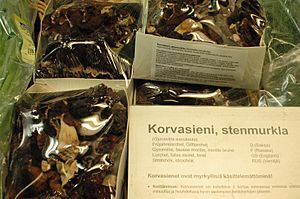
Even though it's known to be toxic, Gyromitra esculenta is still sold and eaten in several countries in Europe and North America. It used to be eaten in Germany, but now Germany and Switzerland advise against eating it and have banned its sale. In Sweden, the food authority warns that it's not safe for human consumption and only allows restaurants to buy fresh mushrooms. However, it's still highly valued and eaten in Bulgaria. In some parts of Spain, especially in the eastern Pyrenees, it's traditionally seen as a special food, and many people say they've eaten it for years without problems. Despite this, the false morel is listed as dangerous in official Spanish mushroom lists, and its sale to the public is banned across Spain. Outside of Europe, Gyromitra esculenta is eaten in the Great Lakes region and some western states in the United States.
Selling and buying fresh false morels is legal in Finland, where they are highly regarded. However, by law, these mushrooms must come with a warning that they are poisonous and clear instructions on how to prepare them safely. False morels are also sold already prepared and canned, making them ready to use. In 2007, Finland sold 32.7 tonnes (about 72,000 pounds) of false morels. In Finnish cuisine, false morels can be cooked in an omelette, gently fried in butter, or used to make a béchamel sauce or pie filling. You can also add more liquid to make a false morel soup. Common seasonings include parsley, chives, dill, and black pepper.
It's important to know that while cooking removes the toxins from the mushrooms, the steam released during cooking can contain these toxins. So, the person cooking can breathe them in.
Preparation
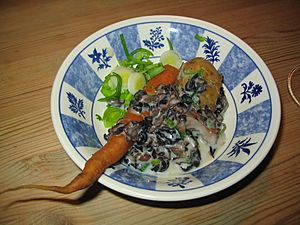
Most of the gyromitrin must be removed to make false morels safe to eat. The recommended way to prepare them is to either dry them first and then boil them, or boil the fresh mushrooms directly.
To prepare fresh mushrooms, it's suggested to cut them into small pieces and boil them twice in a lot of water (at least three parts water to one part chopped mushrooms) for at least five minutes each time. After each boiling, the mushrooms should be rinsed very well in clean water. Each boiling reduces the gyromitrin content significantly. The gyromitrin goes into the water, so the boiling water must be thrown away and replaced with fresh water after each boiling. Even after drying, it's still recommended to boil the mushrooms.
The toxin MMH turns into vapor at 87.5°C (189.5°F), so it easily goes into the air when the mushrooms are boiled. If you boil the mushrooms indoors in a place with poor air circulation, the vapor can build up, leading to poisoning. If you are boiling mushrooms indoors, make sure there is plenty of fresh air. If you start to feel symptoms of gyromitrin poisoning, immediately go outside for fresh air. Even after boiling, small amounts of gyromitrin can remain in the mushrooms. Because toxins can build up in your body, it's not recommended to eat these mushrooms repeatedly.
Future Cultivation
Scientists have found types of Gyromitra esculenta that have much lower amounts of gyromitrin. They have also successfully grown the fungus in labs. This means there's a chance for future research to grow safer types of this mushroom.
See also
 In Spanish: Bonete o Falsa Colmenilla para niños
In Spanish: Bonete o Falsa Colmenilla para niños


